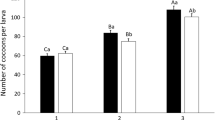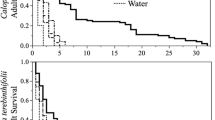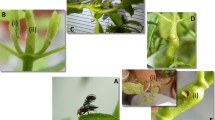Abstract
Two tingidsDictyla echii Schrank andD. nassata Puton are common in the mediterranean region on variousBoraginaceae and are found frequently onEchium plantagineum L.
These insects can reduce or even prevent seed formation due to depigmentation and destruction of leaf and mesophyll cells. Both tingids pass through at least 2 or 3 generations per year.
The range of plants exposed during specificity tests was selected on criteria established byWapshere & Kirk (1977) and included notably:
-
-Boraginaceae and plants closely related to them;
-
- plants representative of the same families on which the same or otherDictyla spp had been recorded. Since onlyBoraginaceae were attacked, this confirmed the specificity of the 2Dictyla spp. to that plant family.
The coexistence in Portugal of both species in the same sites, althoughD. nassata requires a warmer climate thanS. echii, suggests that there is only a small amount of direct interspecific competition. For the above reasons it appears that the 2Dictyla spp. are suitable agents for the biological control ofE. plantagineum in Australia.
Résumé
Dictyla echii Schrank etDictyla nassata Puton sont 2 tingides communément répandus autour du Bassin mediterranéen, vivant aux dépens des Boraginacées et spcialement inféodés àEchium plantagineum L.
Ils ont une activité spoliatrice des tissus végétaux conduisant à un dépérissement rapide de la plante par déchlorophyllisation et réduisant ou même bloquant toute formation de graines. De plus ces insectes ont 2 à 3 générations par an.
Durant les tests de spécificité, toute une gamme de plantes fut exposée à ces punaises; depuis les Boraginacées et les plantes qui leur sont apparentées jusqu'à des végétaux de la même famille ainsi que ceux sur lesquels ces tingides furent collectés par hasard. La spécificité desDyctila spp. fut ainsi confirmée par l'attaque des Boraginacées uniquement. D'autre part, la cohabitation des 2 espèces sur certains sites portugais en nombre à peu près équivalent, bien queD. nassata soit plus thermophile, peut laisser croire à l'absence de compétition interspécifique. Il apparaît donc que ces insectes sont des candidats potentiels tout à fait valables pour la lutte biologique en Australie contreEchium plantagineum.
Similar content being viewed by others
References
Balachowsky, A.S. — 1962. Entomologie Appliquée à l'Agricuture. Tome I, Coléoptères. vol. 1 —Masson, Paris, 564 p.
Balachowsky, A & Mesnil, L. — 1935–1936. Les insectes nuisibles aux plantes cultivées. vol. 1 — Paris, 277–281.
Cashmore, A.B. &Campbell, T.G. — 1946. The weed problem in Australia. A review —Australia Council Sci. Indust. Res. J., 19, 16–31.
Drake, C.J. & Ruhoff. F.A. — 1960. Lacebugs of the World. —U.S. Nat. Bull., 243, 534 pp.
Duarte Rodrigues, P. — 1977 Contribuçao para o cohecimento dos tingideos de Portugal [Insecta, Heteroptera]. —Arquivos Mus. Bocage (2 sér.), 6, 95–104.
Gulde, J. — 1934–1941. Die Wanzer mitteleuropas. Hemiptera Heteroptera Mitteleuropas. —Int. Entomol. Vereins E.V., Frankfurt A.M.
Khaidarova, Z.M. — 1975. Insects that feed on the weedTrichodesma incanum (Bge) D.C. in Uzbekistan —Entomol. Rev. Wash. 54, 50–54 (Translation ofEntomol. Obozr.), 54, 780–786.
Putchkov, V.G. — 1974.Berytidae, Pyrrhocoridae, Piesmatidae, Aradidae andTingidae. —Fauna Ukraini. 21, 1–332.
Puton, A. — 1979. Synopsis des Hemiptères — Hétéroptères de France. 2ème partie: Tingides, Aradides. —Deyrolle, Paris, 84–159.
Stichel, W. — Illustrierte Bestimmungstabellen der Wanzen. II. Europa (Hemiptera —Heteroptoa europae). Part. 3. —Hermsdorf, Berlin.
Wapshere, A.J. — 1981. The biological control of Paterson's curse,Echium plantagineum; northern hemisphere studies. —Int. Symp. Biol. Control Weeds 5th: 1980: Brisbane, (E.S. Del Fosse ed.) C.S.I.R.O., Melbourne, 599–602.
Wapshere, A.J. &Kirk, A.A. — 1977. The biology and host specificity of theEchium leaf minerDialectica scalariella Zeller [Lepidoptera, Gracillariidae]. —Bull. Entomol. Res., 67, 627–633.
Author information
Authors and Affiliations
Rights and permissions
About this article
Cite this article
Vayssieres, J.F. Life histories and host specificities of theEchium bugsDictyla echii andDictyla nassata [Hem.: Tingidae]. Entomophaga 28, 135–143 (1983). https://doi.org/10.1007/BF02372137
Issue Date:
DOI: https://doi.org/10.1007/BF02372137




